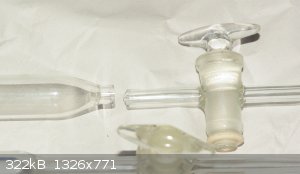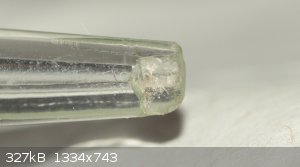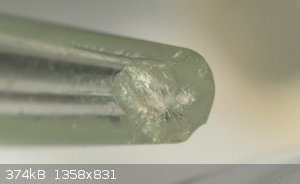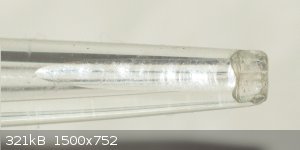NEMO-Chemistry
International Hazard
    
Posts: 1559
Registered: 29-5-2016
Location: UK
Member Is Offline
Mood: No Mood
|
|
Burette question
I broke my first one! I then managed to save up and get another, i was also given one, now a small accident today has resulted in a tiny bit of the
tip being chipped off.
I have tried to take pic but its very small and i need to borrow a better camera to take a pic of it. Before that i thought it might be worth asking
the question anyway.
Is it likely to be ok accuracy wise? the chip is literally a small portion on half of one side of the tip. You dont notice unless you run your finger
along the tip and look closely, it dosnt affect the entire end of the tip just one side of the very tip..........
Its fucked isnt it? 
|
|
|
blogfast25
International Hazard
    
Posts: 10562
Registered: 3-2-2008
Location: Neverland
Member Is Offline
Mood: No Mood
|
|
It'll probably be OK, actually. Just check how your titrant flows out. One drop should be about 0.05 ml.
For 'hobby' purposes your slightly chipped burette should probably do.
[Edited on 12-7-2016 by blogfast25]
|
|
|
NEMO-Chemistry
International Hazard
    
Posts: 1559
Registered: 29-5-2016
Location: UK
Member Is Offline
Mood: No Mood
|
|
Quote: Originally posted by blogfast25  |
It'll probably be OK, actually. Just check how your titrant flows out. One drop should be about 0.05 ml.
For 'hobby' purposes your slightly chipped burette should probably do.
[Edited on 12-7-2016 by blogfast25] |
Thanks  , with my luck lately i was convinced it would be bad news. The other i
broke the entire tip and tap clean off, it could be used as chromatography though. , with my luck lately i was convinced it would be bad news. The other i
broke the entire tip and tap clean off, it could be used as chromatography though.
Not sure if its because i am short or the sink high, but these long ones i have seem to catch the edge of the sink when i wash them out or clean them.
I am tempted to buy a much shorter one 
|
|
|
NEMO-Chemistry
International Hazard
    
Posts: 1559
Registered: 29-5-2016
Location: UK
Member Is Offline
Mood: No Mood
|
|
Found a way to get pics  , dosnt look too bad when zoomed in , dosnt look too bad when zoomed in  
   
|
|
|
blogfast25
International Hazard
    
Posts: 10562
Registered: 3-2-2008
Location: Neverland
Member Is Offline
Mood: No Mood
|
|
Should be OK. The flow channel itself seems unaffected (only just). Bit of a narrow escape, methinks.
You will still have to test it, of course.
[Edited on 12-7-2016 by blogfast25]
|
|
|
Sulaiman
International Hazard
    
Posts: 3928
Registered: 8-2-2015
Member Is Online
|
|
I got a few used burettes as part of an eBay job lot, two had chipped tips.
I used sandpaper to flatten the tips then 'round off' the tips
now they seem ok.
The important thing is to have the same quantity of liquid left in/on the tip each time the tap is closed to 'cancel' the error.
Also, if your burette is not spotlessly clean drops of liquid 'stick' to the inner wall of the burette, giving even worse accuracy errors.
|
|
|
NEMO-Chemistry
International Hazard
    
Posts: 1559
Registered: 29-5-2016
Location: UK
Member Is Offline
Mood: No Mood
|
|
I also noticed on one it has fewer graduations. it is marked in cm cubed but it is marked say 10 then 5 smaller marks then a larger one then 12. so
each smaller grad is .2ml? It is a class B.
I will get a better one once i have a decent analytical balance, little point having an accurate burette when i cant measure 1mg accurately.
I try and be careful with them but the work area is small and they are pretty long, i need to alter my work space and get longer legs and arms! Or
lower the sink, i would prefer longer legs and arms but lowering the sink is a cheaper easier option  . .
Wasnt easy to see the channel until i could take a pic, surprised i got away it 
[Edited on 13-7-2016 by NEMO-Chemistry]
|
|
|
Sulaiman
International Hazard
    
Posts: 3928
Registered: 8-2-2015
Member Is Online
|
|
Unless your lab/liquid is at a constant 20C your Class-A burette will deliver inaccurate volumes
(e.g. for water, 15C = 0.1% error compared to 20C)
you can measure temperatures and compensate if required.
The same applies to volumetric flasks etc.
OTOH
Mass determination using cheap (calibrated) digital scales is temperature independant,
so unless for 'the look' or convenience, volumetric flasks are redundant.
Then there is determination of end point which requires a good indicator and excellent mixing.
Last but not least is preparing titrants of accurate titer/molarity
Here is a good test of your titration skills ;
. make up a c1M solution of sodium carbonate ('cooked' bicarbonate of soda) accurately
. make up c1M acids, e.g. HCl, HNO3, H2SO4 etc.
. Titrate each of the acids as accurately as you can
. Make a c1M solution of KOH or NaOH and use the titrated acids to determine the molarity
. did you get identical results for each acid ?
At least you (and I) now have a set of acid & base titrants of approximately known molarity 
EDIT: based on the above practice I am now confident in my weighing and titration skills to 0.25% error.
(for simple acid/base titrations)
[Edited on 13-7-2016 by Sulaiman]
|
|
|
NEMO-Chemistry
International Hazard
    
Posts: 1559
Registered: 29-5-2016
Location: UK
Member Is Offline
Mood: No Mood
|
|
Quote: Originally posted by Sulaiman  | Unless your lab/liquid is at a constant 20C your Class-A burette will deliver inaccurate volumes
(e.g. for water, 15C = 0.1% error compared to 20C)
you can measure temperatures and compensate if required.
The same applies to volumetric flasks etc.
OTOH
Mass determination using cheap (calibrated) digital scales is temperature independant,
so unless for 'the look' or convenience, volumetric flasks are redundant.
Then there is determination of end point which requires a good indicator and excellent mixing.
Last but not least is preparing titrants of accurate titer/molarity
Here is a good test of your titration skills ;
. make up a c1M solution of sodium carbonate ('cooked' bicarbonate of soda) accurately
. make up c1M acids, e.g. HCl, HNO3, H2SO4 etc.
. Titrate each of the acids as accurately as you can
. Make a c1M solution of KOH or NaOH and use the titrated acids to determine the molarity
. did you get identical results for each acid ?
At least you (and I) now have a set of acid & base titrants of approximately known molarity 
EDIT: based on the above practice I am now confident in my weighing and titration skills to 0.25% error.
(for simple acid/base titrations)
[Edited on 13-7-2016 by Sulaiman] |
I will try this tomorrow, i have to dry some bicarb first which will probably take me most of today.
I like the challenge of titrations, useful skill! I am also going to boil some deionized water to get rid the CO2, maybe a bit over the top
considering my equipment but might as well cut out or diminish as many errors as you can..
|
|
|
blogfast25
International Hazard
    
Posts: 10562
Registered: 3-2-2008
Location: Neverland
Member Is Offline
Mood: No Mood
|
|
Quote: Originally posted by NEMO-Chemistry  | Quote: Originally posted by Sulaiman  | Unless your lab/liquid is at a constant 20C your Class-A burette will deliver inaccurate volumes
(e.g. for water, 15C = 0.1% error compared to 20C)
you can measure temperatures and compensate if required.
The same applies to volumetric flasks etc.
OTOH
Mass determination using cheap (calibrated) digital scales is temperature independant,
so unless for 'the look' or convenience, volumetric flasks are redundant.
Then there is determination of end point which requires a good indicator and excellent mixing.
Last but not least is preparing titrants of accurate titer/molarity
Here is a good test of your titration skills ;
. make up a c1M solution of sodium carbonate ('cooked' bicarbonate of soda) accurately
. make up c1M acids, e.g. HCl, HNO3, H2SO4 etc.
. Titrate each of the acids as accurately as you can
. Make a c1M solution of KOH or NaOH and use the titrated acids to determine the molarity
. did you get identical results for each acid ?
At least you (and I) now have a set of acid & base titrants of approximately known molarity 
EDIT: based on the above practice I am now confident in my weighing and titration skills to 0.25% error.
(for simple acid/base titrations)
[Edited on 13-7-2016 by Sulaiman] |
I will try this tomorrow, i have to dry some bicarb first which will probably take me most of today.
I like the challenge of titrations, useful skill! I am also going to boil some deionized water to get rid the CO2, maybe a bit over the top
considering my equipment but might as well cut out or diminish as many errors as you can.. |
| Quote: | | . make up a c1M solution of sodium carbonate ('cooked' bicarbonate of soda) accurately |
If only it was that simple. Sulaiman is of course referring to the process of Standardisation. As with any measuring method you need a primary
standard.
Highly pure, anhydrous sodium carbonate is not a bad primary standard (I use it myself) but you'll need high purity NaHCO3 for that (or
recrystallise and dehydrate washing soda) and supermarket stuff is rarely that good.
What's more, carbonates are bibasic so assuming you titrate to full neutralisation of the base with a 0.1 M monoprotic acid titrant, it's
best to use 0.05 M sodium carbonate primary standard solution (aka 0.1 N, i.e. 'Normal' instead of molar)
Consider also other Primary Standards, like potassium hydrogenphthalate (KHP), which is not OTC and harder to get.
| Quote: | The same applies to volumetric flasks etc.
OTOH
Mass determination using cheap (calibrated) digital scales is temperature independant,
so unless for 'the look' or convenience, volumetric flasks are redundant. |
Huh? Unless you want to weigh everything, decent, calibrated volumetric flasks remain the go-to guys for preparing solutions of accurately
known concentrations. And not just in titrometry either...
How many here have scales that can weigh say 300 g to 1 mg accurate?
[Edited on 13-7-2016 by blogfast25]
|
|
|
NEMO-Chemistry
International Hazard
    
Posts: 1559
Registered: 29-5-2016
Location: UK
Member Is Offline
Mood: No Mood
|
|
Quote: Originally posted by blogfast25  | Quote: Originally posted by NEMO-Chemistry  | Quote: Originally posted by Sulaiman  | Unless your lab/liquid is at a constant 20C your Class-A burette will deliver inaccurate volumes
(e.g. for water, 15C = 0.1% error compared to 20C)
you can measure temperatures and compensate if required.
The same applies to volumetric flasks etc.
OTOH
Mass determination using cheap (calibrated) digital scales is temperature independant,
so unless for 'the look' or convenience, volumetric flasks are redundant.
Then there is determination of end point which requires a good indicator and excellent mixing.
Last but not least is preparing titrants of accurate titer/molarity
Here is a good test of your titration skills ;
. make up a c1M solution of sodium carbonate ('cooked' bicarbonate of soda) accurately
. make up c1M acids, e.g. HCl, HNO3, H2SO4 etc.
. Titrate each of the acids as accurately as you can
. Make a c1M solution of KOH or NaOH and use the titrated acids to determine the molarity
. did you get identical results for each acid ?
At least you (and I) now have a set of acid & base titrants of approximately known molarity 
EDIT: based on the above practice I am now confident in my weighing and titration skills to 0.25% error.
(for simple acid/base titrations)
[Edited on 13-7-2016 by Sulaiman] |
I will try this tomorrow, i have to dry some bicarb first which will probably take me most of today.
I like the challenge of titrations, useful skill! I am also going to boil some deionized water to get rid the CO2, maybe a bit over the top
considering my equipment but might as well cut out or diminish as many errors as you can.. |
| Quote: | | . make up a c1M solution of sodium carbonate ('cooked' bicarbonate of soda) accurately |
If only it was that simple. Sulaiman is of course referring to the process of Standardisation. As with any measuring method you need a primary
standard.
Highly pure, anhydrous sodium carbonate is not a bad primary standard (I use it myself) but you'll need high purity NaHCO3 for that (or
recrystallise and dehydrate washing soda) and supermarket stuff is rarely that good.
What's more, carbonates are bibasic so assuming you titrate to full neutralisation of the base with a 0.1 M monoprotic acid titrant, it's
best to use 0.05 M sodium carbonate primary standard solution (aka 0.1 N, i.e. 'Normal' instead of molar)
Consider also other Primary Standards, like potassium hydrogenphthalate (KHP), which is not OTC and harder to get.
| Quote: | The same applies to volumetric flasks etc.
OTOH
Mass determination using cheap (calibrated) digital scales is temperature independant,
so unless for 'the look' or convenience, volumetric flasks are redundant. |
Huh? Unless you want to weigh everything, decent, calibrated volumetric flasks remain the go-to guys for preparing solutions of accurately
known concentrations. And not just in titrometry either...
How many here have scales that can weigh say 300 g to 1 mg accurate?
[Edited on 13-7-2016 by blogfast25] |
The acid (i forget the name!) was mentioned in the other thread, i am having trouble getting hold of it. The sodium carbonate i did get 200g from
school of the stuff they use for standard solutions.
I thought might be an idea once i get hold of the acid if i titrate the school stuff and see if i can purify the normal carbonated i have and compare
the two.
my best scales are like the small drug dealer cheapo ones, they weigh 250g down to 1mg, but they cant measure below an initial 50mg (i think??).
Decent balance is on my list, but it takes time to save for it and then find a decent one on ebay second hand.
thanks for the info, i get confused with molar and Normal
|
|
|
Sulaiman
International Hazard
    
Posts: 3928
Registered: 8-2-2015
Member Is Online
|
|
Blogfast25 "How many here have scales that can weigh say 300 g to 1 mg accurate?"
..............................
AFAIK, Class-A / USP volumetric flasks with certificate/serial number are not that accurate,
e.g. 50 ml +/- 0.06 ml = 0.12%, 100 ml +/-0.1ml = 0.1%,
which are easily beaten by my cheap Chinese 300g x 0.01g digital scales 
(which need frequent re-callibration)
Anyway, what I should have typed was,
use volumetric flasks if you have them
but if not, save cash by using scales,
which are usually required for quantitative analysis.
EDIT: NEMO-Chemistry , your scales are more precise than volumetric flasks.
Consider all sources of error and minimise the significant ones,
I suspect that the greatest source of error will be reagent/titrant purity and burette errors.
See if you can do the exercise I mentioned and you will learn why.
Also, H2SO4 is di-protic. (1M = 2N)
[Edited on 13-7-2016 by Sulaiman]
|
|
|
blogfast25
International Hazard
    
Posts: 10562
Registered: 3-2-2008
Location: Neverland
Member Is Offline
Mood: No Mood
|
|
Quote: Originally posted by Sulaiman  | Blogfast25
How many here have scales that can weigh say 300 g to 1 mg accurate?
..............................
AFAIK, Class-A / USP volumetric flasks with certificate/serial number are not that accurate,
e.g. 50 ml +/- 0.06 ml = 0.12%, 100 ml +/-0.1ml = 0.1%,
which are easily beaten by my cheap Chinese 300g x 0.01g digital scales 
(which need frequent re-callibration)
Anyway, what I should have typed was,
use volumetric flasks if you have them
but if not, save cash by using scales,
which are required for quantitative alalysis.
|
Would you also use those 'cheap Chinese 300g x 0.01g digital scales' to weigh the 0.56 g of sodium carbonate needed for a 100 ml of 0.05 M solution?
That's less than 4 titrations if you take the rinsing into account, BTW. And no outliers, of course.
You're over-simplifying to try and score points. You're welcome to them. 
There's more than one way to skin a cat, Sulaiman.
|
|
|
NEMO-Chemistry
International Hazard
    
Posts: 1559
Registered: 29-5-2016
Location: UK
Member Is Offline
Mood: No Mood
|
|
For now practice of technique and getting reproducible results are probably my main goal. Better equipment will come in time (with luck).
|
|
|
blogfast25
International Hazard
    
Posts: 10562
Registered: 3-2-2008
Location: Neverland
Member Is Offline
Mood: No Mood
|
|
Molarity = number of moles/litre
Normality = number of equivalents/litre
1 equivalent = 1mol/valency
Example:
H3PO4 is a trivalent acid, MM = 97.99 g/mol
1 equivalent of PA = 32.66 g
Make, say 250 ml of 0.1 N PA, requires:
g PA = 250 ml x 1 L/1000 ml x 0.1 equivalent PA/L x 32.66 g PA/equivalent PA = 0.8165 g PA.
Titrating such a solution will always require the same titrant volume as analyte volume, as long as the titrant is also 0.1 N.
|
|
|